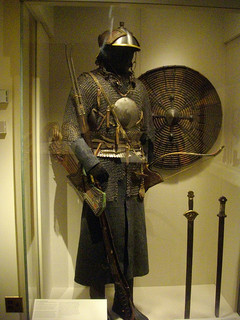Difference between revisions of "Tibet"
From SamuraiWiki
Jump to navigationJump to search (Created page with "right|thumb|320px|A suit of 18th-19th c. Tibetan armor, shield, and weapons. [[Metropolitan Museum of Art.]] Tibet is a center of Himalayan Buddhis...") |
|||
| Line 4: | Line 4: | ||
By the eighth century, Tibet had become one of China's most powerful neighbors; from the 760s-780s, Tibetan forces raided the [[Tang Dynasty]] capital of [[Chang'an]] every autumn. Raids grew less frequent after that, but continued into the 9th century, when the kingdom of Tibet began to decline. | By the eighth century, Tibet had become one of China's most powerful neighbors; from the 760s-780s, Tibetan forces raided the [[Tang Dynasty]] capital of [[Chang'an]] every autumn. Raids grew less frequent after that, but continued into the 9th century, when the kingdom of Tibet began to decline. | ||
| + | |||
| + | Never controlled by a Chinese dynasty until the mid-[[Qing Dynasty]], Tibet remained under Qing control only until the end of that dynasty in [[1911]]. The following year, imperial officials and garrisons vacated the region.<ref>Ping-Ti Ho, "The Significance of the Ch'ing Period in Chinese History," ''Journal of Asian Studies'' 26:2 (1967), 190.</ref> | ||
{{stub}} | {{stub}} | ||
| Line 9: | Line 11: | ||
==References== | ==References== | ||
*Valerie Hansen, ''The Open Empire'', New York: W.W. Norton & Company (2000), 227. | *Valerie Hansen, ''The Open Empire'', New York: W.W. Norton & Company (2000), 227. | ||
| + | <references/> | ||
[[Category:Geographic Locations]] | [[Category:Geographic Locations]] | ||
Revision as of 15:19, 6 January 2015

A suit of 18th-19th c. Tibetan armor, shield, and weapons. Metropolitan Museum of Art.
Tibet is a center of Himalayan Buddhism, and was a powerful independent kingdom for many centuries, until its conquest by Chinese Communist forces in 1949.
By the eighth century, Tibet had become one of China's most powerful neighbors; from the 760s-780s, Tibetan forces raided the Tang Dynasty capital of Chang'an every autumn. Raids grew less frequent after that, but continued into the 9th century, when the kingdom of Tibet began to decline.
Never controlled by a Chinese dynasty until the mid-Qing Dynasty, Tibet remained under Qing control only until the end of that dynasty in 1911. The following year, imperial officials and garrisons vacated the region.[1]
References
- Valerie Hansen, The Open Empire, New York: W.W. Norton & Company (2000), 227.
- ↑ Ping-Ti Ho, "The Significance of the Ch'ing Period in Chinese History," Journal of Asian Studies 26:2 (1967), 190.